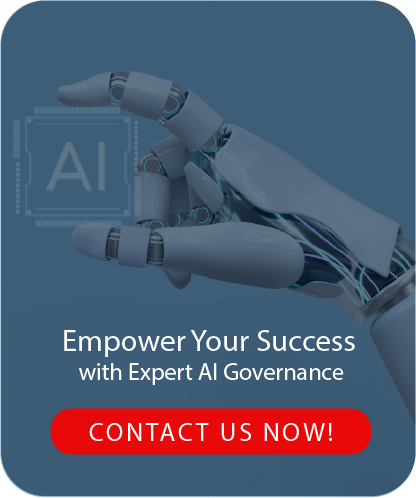Have you ever wondered why some AI-powered businesses succeed while others experience expensive failures? One crucial element holds the solution.Enterprise AI governance distinguishes prosperous companies from those mired in reputational catastrophes and compliance nightmares.
Are you prepared to use bulletproof governance to revolutionize your AI strategy? Get in touch with us right now to find out how our knowledgeable staff can protect the AI future of your company.
What Exactly Is Enterprise AI Governance?
Think of enterprise AI governance as your organization's safety net. It's the collection of rules, processes, and safeguards that keep your AI systems running smoothly. Unlike basic AI policies, true governance covers everything from design to retirement.
Smart companies treat AI governance like a living system. They build frameworks that adapt as technology evolves. This approach prevents the chaos we see when AI systems operate without proper oversight.

The Hidden Costs of Poor AI Governance
Businesses that don't have adequate AI governance risk dire repercussions. After employees leaked confidential code, Samsung banned ChatGPT. Within hours, Microsoft's Tay chatbot turned into a PR nightmare. These instances illustrate the consequences of poor governance.
According to recent studies, 80% of business executives believe that trust and ethics in AI are significant obstacles. Businesses spend millions correcting avoidable AI errors. Beyond fines, the financial impact also includes lost revenue and tarnished reputations.
Building Your Enterprise AI Governance Foundation
Core Principles That Drive Success
Six essential pillars support effective AI governance:
Transparency guarantees that everyone is aware of the decision-making process of AI. Any AI recommendations should be explained by your team to regulators or stakeholders.
Being accountable entails accepting responsibility for the results of AI. When problems occur, having clear ownership avoids assigning blame.
Bias that could hurt people or groups is eliminated by fairness. This principle guards against ethical transgressions and discrimination lawsuits.
Throughout the AI lifecycle, sensitive data is protected by privacy protection. Robust privacy controls guard against data breaches and fines from the government.
Data poisoning and prompt injection attacks are prevented by security measures. These dangers have the potential to compromise your AI systems and reveal private data.
Compliance alignment guarantees that your AI complies with all relevant legal requirements. Regulations are becoming more stringent by the day, from the GDPR to the EU AI Act.
Creating Your Governance Structure
Start by forming a cross-functional AI governance committee. Include representatives from legal, IT, compliance, and business units. This diverse team provides comprehensive oversight across all AI initiatives.
Assign specific roles within your governance framework:
- Chief AI Officer sets strategic direction
- AI Ethics Officers guide responsible development
- Compliance Managers ensure regulatory adherence
- Data Scientists maintain technical standards
Wondering how to implement these governance principles in your organization? Contact us to schedule a consultation with our AI governance specialists.
Managing AI Risks Like a Pro

Identifying Potential Threats
There are three primary types of AI risks. Security lapses and system failures are examples of technical risks. Bias and unfair treatment are examples of ethical risks. Violations of data protection laws are associated with compliance risks.
Create a risk map for your whole AI ecosystem. Think about the potential failures and consequences of each AI application. Vulnerabilities are exposed by this exercise before they become issues.
Smart Mitigation Strategies
Implement human oversight at critical decision points. Use "human in the loop" validation for high-risk decisions. Apply "human over the loop" monitoring for ongoing operations.
Build robust data governance frameworks. Ensure training data quality and eliminate biased datasets. Regular audits catch problems early.
Deploy automated monitoring systems. These tools detect anomalies and performance drift in real-time. Quick detection enables rapid response to emerging issues.
Practical Implementation Steps
Start With Policy Development
Create comprehensive AI policies that align with your business objectives. Define acceptable use cases and prohibited applications. Establish clear approval processes for new AI projects.
Document everything thoroughly. Good documentation streamlines employee training and regulatory audits. It also helps maintain consistency across teams.
Operationalize Your Framework
Integrate AI policies into existing business processes. Train employees on proper AI usage and governance requirements. Provide sufficient resources for policy enforcement.
Set up continuous monitoring systems. Track compliance with internal policies and external regulations. Implement reporting mechanisms for policy violations.
Ready to operationalize AI governance in your enterprise? Contact us for a customized implementation roadmap that fits your organization's unique needs.
Staying Ahead of Regulatory Changes
The regulatory landscape for AI governance evolves rapidly. The EU AI Act introduces strict requirements for high-risk AI systems. GDPR already impacts AI applications processing personal data.
Organizations must monitor regulatory developments closely. Subscribe to industry updates and participate in professional associations. Build flexibility into your governance framework to accommodate new requirements.
Your Next Steps Forward
Enterprise AI governance isn't optional anymore. It's a business necessity that protects your organization while enabling innovation. Companies that implement robust governance frameworks today will lead their industries tomorrow.
Start by assessing your current AI governance maturity. Identify gaps between your existing practices and best practices. Develop a roadmap for closing those gaps systematically.
Remember that governance evolves with your AI capabilities. Regular reviews and updates keep your framework effective as technology advances.
The organizations that master AI governance will capture the full value of artificial intelligence. Those that don't will face mounting risks and missed opportunities. Which path will your organization choose?






